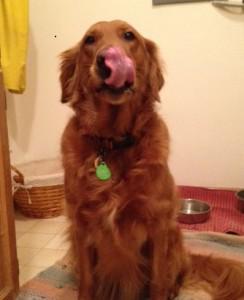 I’m busy writing away upstairs. Last time I looked, it was 4:00 in the afternoon. Suddenly, I hear my dog Tasha get up off the floor next to me, she shakes, she moves in closer, and I can feel her expectant stare right on me. It’s 5:45, and the dinner routine is about to start–just 15 minutes from can-opening time, and somehow, she knows it. I might still be consumed with work, but at this point, I have no choice but to pull myself away from the computer and out of my chair. I must trundle downstairs to attend to the needs of my dog.
I’m busy writing away upstairs. Last time I looked, it was 4:00 in the afternoon. Suddenly, I hear my dog Tasha get up off the floor next to me, she shakes, she moves in closer, and I can feel her expectant stare right on me. It’s 5:45, and the dinner routine is about to start–just 15 minutes from can-opening time, and somehow, she knows it. I might still be consumed with work, but at this point, I have no choice but to pull myself away from the computer and out of my chair. I must trundle downstairs to attend to the needs of my dog.
I didn’t mean to train her to eat at such a specific time, but 6 o’clock it is–every night. On the dot. If I stay out late, I think Tasha sits beside her food bowl, waiting for me to come home and get on with it. She’s always right where she should be, sitting patiently (but not too patiently), and drooling to her heart’s content.
I’ve heard that it’s not good to feed your dog at the same time every night. I don’t remember where or why, but there’s no going back now. Tasha is set for life. Even when I go out of town and leave her in the care of a dog sitter or a friend, I’m told she’s as prompt as ever. The dog sitter or friend who doesn’t heed the hour is in for some substandard doggie behavior. There might even be some whining.
So I’m downstairs near the kitchen and the “dog room.” If I hesitate in the least, Tasha is right beside me, doing her best not to be just a dog, but a force of nature to be reckoned with. There’s no ignoring it–she’s restless, she paces, and she drools some more. Her anticipation is stunning. I could be doing just about anything in the kitchen, but whatever it is, it’s not on her list.
I didn’t make up this dinner routine, and I don’t remember how it started, but now it’s etched in her canine consciousness. The routine goes something like this: I open the plastic container of dry food that already has the one-cup measure in it. This marks the official beginning of Doggie Dinner. I take the bowl with the dry food from the dog room into the kitchen, where I keep the cans of wet food. (Tasha is a very pampered dog—maybe it’s because she’s a rescue.). She prances not behind, but in front of me. I flip back the lid on a can, and the crowd of one goes wild. In her doggie brain, If think she wonders whether I’m giving her the same food, or if there’s a new flavor this week. It takes me only a few seconds to spoon out half a can of dog food out at the half-can mark. If I haven’t already started running the hot water, it takes another few seconds for it to warm up, just the right temperature to mix with the wet and dry food. I chop it all up with a spoon, but not so much that I feel more obsessive than I already am. It’s back to the dog room with the dog and the dog bowl. As I hold the bowl in front of her, she sits almost automatically as I say “sit.” But she doesn’t need to hear the command. At six-years old, Tasha knows she will be rewarded for good behavior. In one fluid motion, she gets up out of a sit and I put down the food. It’s 6 o’clock on the nose, and my dog knows it.
Despite this hurried preparation, she doesn’t gobble down her food, but she doesn’t dally either. At about 7 minutes after 6, she’s done, and it’s time for the after-dinner routine. Doggie dessert is a biscuit. I get the kind that come in different shapes—a bone, a car, a couch. She sits and drools again, planted right in front of the biscuit box. I pull out the treat and tell her the shape. “It’s a couch!” As if she could get any more excited. She crunches on the treat for a few seconds, and at about 10 minutes after 6, it’s all over. End of the routine. My dog is fed, happy, and content, and for the time being, I am no longer at her mercy.
